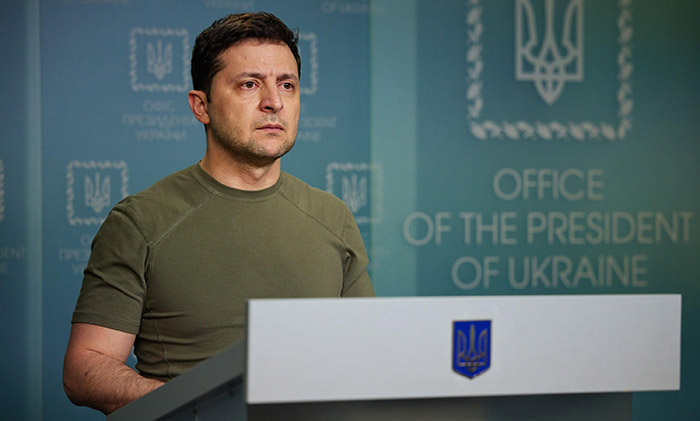Wider World
Feature
Babyn Yar’s Uncertain Future Amid Russian Offensive

Eighty-one years after Babyn Yar, a wooded ravine near Kyiv, Ukraine, witnessed one of the Holocaust’s most notorious massacres, the site is making headlines around the world—and not for the promise of commemoration and revitalization that was heralded there just last year.
Indeed, the mood at Babyn Yar had been optimistic as a synagogue, constructed of recycled prewar wood in the style of traditional Eastern European shuls, was unveiled in May 2021. It marked the joyous re-establishment of a Jewish presence at the mass grave where an estimated 70,000 to 100,000 people were shot by the Nazis in a two-year period, including the murder of nearly the entire Jewish population of Kyiv on September 29 and 30, 1941.
At a later ceremony commemorating the 80th anniversary of the massacre, Ukrainian President Volodymyr Zelenskyy, who is Jewish, laid a wreath at one of the memorials in Babyn Yar. The atrocities carried out there, he said at the event, “should never be repeated. Not in Ukraine. Not anywhere else in Europe. Nowhere in the world.”
The site of so much tragedy seemed on the precipice of a historic rebirth. The Babyn Yar Holocaust Memorial Center planned the synagogue as the first structure in a complex that is slated to include a library, archives and an educational center.
Then, on March 1, as Russian Army forces bombarded Ukrainian cities in what Russian President Vladimir Putin called an operation to “de-Nazify” Ukraine, word came that Babyn Yar had been attacked. Numerous sources confirmed that a Russian missile hit the ravine, the site of the massacre, which is adjacent to Kyiv’s main television tower.

Robert Jan van Pelt, a Holocaust historian and University of Waterloo architecture professor who serves on the memorial center’s architectural advisory board, told Hadassah Magazine on March 3 that the synagogue had been spared, but that “one building on the Babyn Yar site, which was to be transformed into a museum of the history of the site, was hit by a missile.” It is unclear, he said, if the building is a total loss.
Meanwhile, in a March 2 opinion piece for The Forward, the synagogue’s architect, Manuel Herz, decried the bombing of “one of the ‘ground zeros’ of European history” as “another horrific chapter debasing our humanity.” Herz said he envisioned his synagogue as a deliberately humble presence, in contrast to the monumental architecture typical of memorials.

Iwaan Baan/BYHMC.
Built on a wooden platform, Herz’s design deliberately hovers above the sacred ground. Inside, the walls are decorated with Jewish prayers such as the Shema and Kaddish. Colorful motifs inspired by classic Ukrainian synagogue interiors include a painted ceiling that depicts the night sky over Kyiv on September 29, 1941.
But the most unusual element is the synagogue’s “pop-up” design, in which the vertical structure unfolds like a book to reveal the sanctuary. German-born Herz has said that the process of cranking open the temple with a manual winch is intended as a collective ritual, referencing not only the symbolic reopening of Babyn Yar and Kiev Jewry, but also the Jews’ identity as the People of the Book. The synagogue was intended as a gathering space for visiting Jews.

Van Pelt wrote about the synagogue project in An Atlas of Jewish Space, the first of two volumes in the book set How Beautiful Are Your Dwelling Places, Jacob: Documenting the Babyn Yar Synagogue Project, which is scheduled for release in the United States this spring.
Van Pelt called the memorial center’s building projects an invitation “to think with us about what should and can happen here, where the soil is so burdened with history—quite literally.”
As Russian aggression added a new chapter to that history, Zelensky, whose grandfather fought with the Red Army during World War II and lost three brothers in combat, used the Babyn Yar attack to appeal to world Jewry.
“What is the point of saying ‘never again’ for 80 years, if the world stays silent when a bomb drops on the same site of Babyn Yar?” he tweeted on March 1.
The following day, on his Facebook page, Zelenskyy addressed “the Jews of the world” directly on a video that went viral across social media. “Don’t you see what is happening?” he implored, citing the desecration of Babyn Yar, “where thousands of Jews were executed…. It is very important that millions of Jews around the world not remain silent right now.”
As a massive Russian military convoy inched toward Kyiv in early March, the fate of Babyn Yar remained cloudy. Van Pelt summed up the feeling of helplessness for those watching the situation unfold: “Both the present and the future are very uncertain, to be sure.”
Hilary Danailova writes about travel, culture, politics and lifestyle for numerous publications.










 Facebook
Facebook Instagram
Instagram Twitter
Twitter
Yona Hermann says
I said kaddish there when there was no memorial many years ago.
Jay F Brown says
It is a very interesting story, being Jewish in American there are alot that I don’t
know about Judism. This is very interesting.